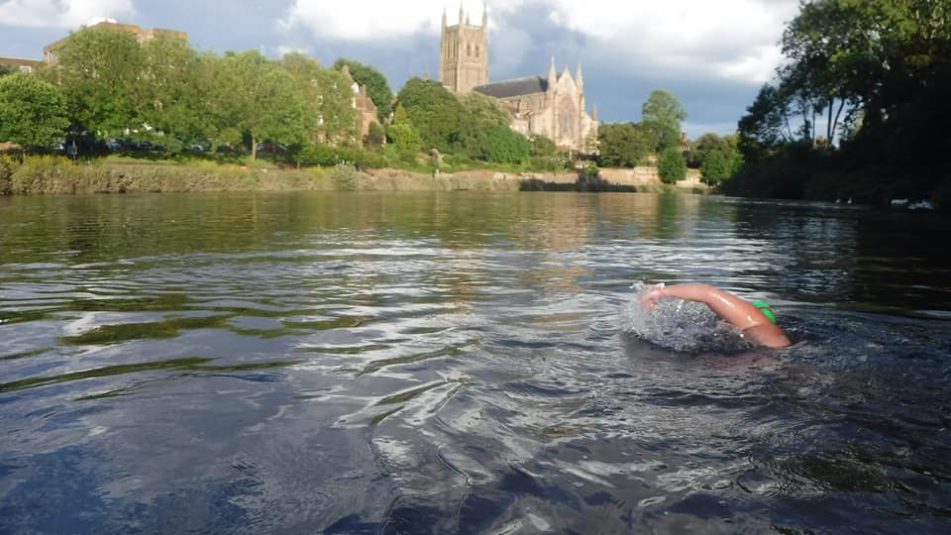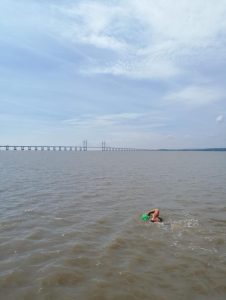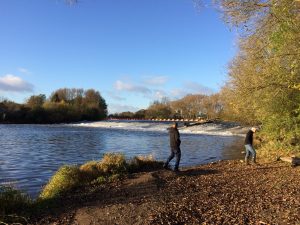
Melissa Compton, has just completed the 220-mile challenge – to swim the length of the Severn from Source to Sea. An intensive care nurse, she loves wild swimming and was motivated to take on the challenge to raise money for Versus Arthritis, a charity which funded stem cell treatment for her damaged knee.
She began the swim in Wales in early June. We caught up with Melissa whilst unseasonable summer-flooding on the river and then sickness necessitated a temporary pause to her swim. She shared her unique insights on the River Severn gained through swimming its entire length.
Why were you inspired to swim the length of the River Severn?
I live near the River Severn in Shropshire around Shrewsbury and swim in it regularly. Around here it is a beautiful wild river.
What are your favourite parts of the River Severn?
My favourite section of the Severn before this adventure was towards the source in and around the Havern Forest. Always see Dippers around there and its clean and fresh. I like the wildness of it there.
Why do you love wild swimming?
I love the freedom; no one can get you, you are alone. I love the solitude swimming brings, the rhythm to breathing and life. You see the world from a different perspective.
Can you tell us what it’s like to experience the river by actually swimming through it, rather than looking down on it from a boat or the towpath?
When you are in the water the wildlife can be less timid of you and less aggressive. I have had had swans go to attack me whilst I am on the bank getting changed but as soon as I am in the water are not interested and swim off. When swimming every thing is seen in snap shots of a few seconds whilst I breath and because I only breath to my right side I can miss lots of stuff, so at times I will swim heads up breaststroke to have a look about. If you are swimming in the river with high banks it can be very boring and monotonous as all you see are the banks and the willow trees that line the river.
What differences have you observed along the length of the River Severn in your swim so far?
The river is ever-changing – it’s been fascinating. At the source and leading down the mountain, the river is crystal clear and cold. The river here is full of life, with a diverse range of flora on it banks. It has waterfalls, deep pools to swim and sections so shallow you could walk across it. As it heads off the mountain the river runs though agricultural land and it becomes less clear. Standard willow and alder trees start to line the river bank. It still remains shallow as it cuts its way through wales out to England. You can see how the banks have eroded and the river has changed its course over time. There is plenty of wildlife including: mallards, swans, Herons, Bees, Dippers, Geese, dragon flies, damsel files. The rocks are slippery from algae and the river is becoming silted. It is running brown and visibility is low under water.
Once I got to Welshpool, I saw the river deepen and narrow. There are more meanders and the river becomes awash with dangerous currents – it feels like it just keeps trying to kill you! It is a very unforgiving place.
The river remains a place of beauty all the way through Shropshire, wildlife is abundant, its a great place to be. There were very few man made interventions to walk around, just the weir in Shrewsbury. The river felt untamed throughout this section. But I could rarely relax as the river was unpredictable. There were lots of cross currents, whirlpools, undercurrents, eddies, micro eddies all making it hard to swim. This was the hardest swimming that I’ve done until this point. We even saw an otter outside Upper Arely.
Leaving Shropshire, the river straightens, widens and feels less wild. You see a lot more people using the river and you go through more built up areas. The river is very silty and doesn’t feel as clean, there becomes a taste of diesel in the water and you notice much more boat traffic. further along the river and with each lock pass the river gets slower and feels dirtier. The noise of the boats underwater can be deafening, and there is less opportunity to see wildlife which is upsetting as it’s one of my favourite things about being in the water. I haven’t enjoyed the swimming since Leaving Worcester. There is lots of boat traffic now, the water is not as clean and the risk of waterborne infection is much higher – I spent a night in hospital after becoming ill.
I am looking forward to the estuary and the mud flats. it widens and the views should appear. I’m also hoping to see some more birds.
Why do you think the river is important, how we might think about it or appreciate it in a different way?
It’s a huge habitat so wildlife if we look after if. It’s beauty is destroyed in the areas that have been harnessed by people. Respect the river and don’t be scared, it can teach you so much.
UPDATE:
After sending us these insights Melissa went on to complete her challenge. Despite set-backs on the way involving flooding, illness, hypothermia and fatigue, plus low-tides in the estuary, she persevered and finally completed her swim at Severn Beach on 8 July. Congratulations Melissa!

If you’re inspired by Melissa’s epic swim, check out her Swimming Melissa Compton Facebook page and her JustGiving page raising money for Versus Arthritis.
FOR YOUR SAFETY
Please note that the River Severn is often not a safe place to swim in. Melissa had Kayak support with her throughout the swim and made sure she was aware of hazards. The risks should not be taken lightly, as Melissa’s own experience shows.
Dangers Include:
- Low temperatures, which can cause the body to go into cold shock and even hypothermia, drawing the blood away from your muscles to protect your organs. This can lead to drowning
- Reeds and other plant life, which can get tangled around limbs and keep you in the water
- Litter, like shopping trolleys, which can trap your feet as well as cause injury
- Depth perception – it could be much shallower than you expect it to be and cause serious harm if someone jumps in, as well as being much deeper than expected in other areas
- Waterborne diseases such as Leptospirosis (Weil’s disease)
For more information on water safety please take a look at these links:


